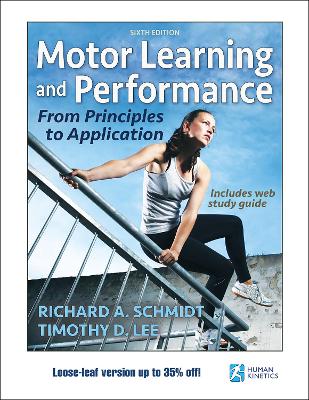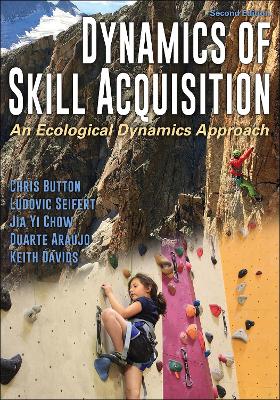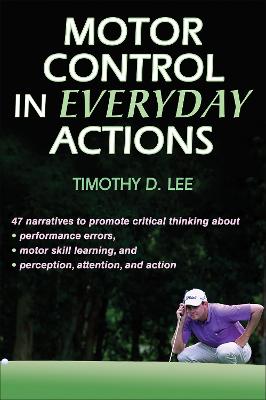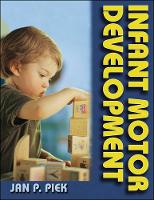Motor Learning and Performance 6th Edition With Web Study Guide-Loose-Leaf Edition
 -15%
portes grátis
-15%
portes grátis
Motor Learning and Performance 6th Edition With Web Study Guide-Loose-Leaf Edition
From Principles to Application
Lee, Timothy D.; Schmidt, Richard A.
Human Kinetics Publishers
09/2019
328
Loose-leaf
Inglês
9781492574682
15 a 20 dias
1066
Why Study Motor Skills?
The Science of Motor Learning and Performance
Focus on Research 1.1: Paul M. Fitts
Focus on Research 1.2: Franklin M. Henry, Father of Motor Behavior Research
Defining Skills
Components of Skills
Classifying Skills
Measuring Skilled Performance
Understanding Performance and Learning
Summary
Learning Aids
Part I. Principles of Skilled Performance
Chapter 2. Processing Information and Making Decisions
The Information-Processing Approach
Focus on Application 2.1: Intent to Blow Whistle Rule in NHL
Reaction Time and Decision Making
Focus on Research 2.1: Donders' Stages of Processing
Focus on Research 2.2: Hick's Law
Focus on Application 2.2: Light Switches
Focus on Research 2.3: Assessing Anticipation Skills
Focus on Application 2.3: Cost/Benefit of Anticipating in Sprint Starting
Memory Systems
Summary
Learning Aids
Chapter 3. Attention and Performance
Focus on Application 3.1: William James on Attention
What Is Attention?
Limitations in Stimulus Identification
Focus on Research 3.1: Automatic Stimulus Processing in Basketball
Limitations in Response Selection
Focus on Research 3.2: Distracted-Driving Research
Limitations in Movement Programming
Focus on Research 3.3: The Double-Stimulation Paradigm
Focus of Attention During Action
Decision Making Under Stress
Focus on Application 3.2: Driver Panic and Unintended Acceleration
Summary
Learning Aids
Chapter 4. Sensory Contributions to Skilled Performance
Sources of Sensory Information
Processing Sensory Information
Focus on Application 4.1: Force Escalation Between Siblings
Principles of Visual Control
Focus on Research 4.1: "Blindsight" Reveals Dorsal and Ventral Stream Processing
Focus on Research 4.2: Gaze Control
Focus on Application 4.2: Visibility in Nighttime Car-Truck Accidents
Audition and Motor Control
Focus on Application 4.3: When Vision Distorts Performance
Summary
Learning Aids
Chapter 5. Motor Programs
Motor Program Theory
Evidence for Motor Programs
Focus on Research 5.1: The Henry-Rogers Experiment
Focus on Application 5.1: Checked Swings in Baseball
Focus on Research 5.2: Initiating a Motor Program
Motor Programs and the Conceptual Model
Problems in Motor Program Theory: Novelty and Storage
Generalized Motor Program Theory
Focus on Research 5.3: Invariances and Parameters
Focus on Application 5.2: Relative-Timing Fingerprints
Focus on Application 5.3: The Stereo System Analogy
Summary
Learning Aids
Chapter 6. Principles of Speed, Accuracy, and Timing
Fitts' Law
Focus on Research 6.1: The Fitts Tasks
Focus on Application 6.1: Fitts' Law in Everyday Actions
Schmidt's Law
Speed-Accuracy Trade-Off Exceptions
Applying the Principles: Baseball Batting
Speed of Initiating Movement
Summary
Learning Aids
Chapter 7. Performance of Complex Movements
Traditional Approaches to Studying Complex Movement
Focus on Application 7.1: The Relative-Age Effect
Coordinating Discrete Movements
Focus on Research 7.1: Coordination in Golf Putting
Coordinating Continuous Movements
Focus on Research 7.2: Relative Phase: An Index of Coordination
Summary
Learning Aids
Part II. Principles of Skill Learning
Chapter 8. Introduction to Motor Learning
Motor Learning Defined
How Is Motor Learning Measured?
Focus on Research 8.1: Learning Curves: Facts or Artifacts?
Distinguishing Learning from Performance
Focus on Application 8.1: Self-Assessments of Learning
Transfer of Learning
Summary
Learning Aids
Chapter 9. The Motor Learning Process
Skill Acquisition
Focus on Research 9.1: Learning Never Ends
Focus on Application 9.1: Fitts and Bernstein on Learning to Play Ice Hockey
Focus on Research 9.2: A Constraints-Led Approach to Baseball Batting
Skill Retention
Skill Transfer
Summary
Learning Aids
Chapter 10. Organizing and Scheduling Practice
Motivation for Learning
Attentional Focus
Demonstrations and Modeling
Mental Practice
Focus on Application 10.1: Mental Practice in Stroke Rehabilitation
Organizing Practice and Rest Periods
Variable and Constant Practice
Focus on Research 10.1: Especial Skills: An Exception to Variable Practice?
Blocked and Random Practice
Summary
Learning Aids
Chapter 11. Augmented Feedback
Feedback Classifications
Functions of Augmented Feedback
Focus on Research 11.1: How Feedback Works
What Feedback to Give
How Much Feedback to Give
Feedback Timing
Focus on Application 11.1: Physical Guidance in Stroke Rehabilitation
Focus on Application 11.2: Physical Guidance in Learning to Swim
Summary
Learning Aids
Why Study Motor Skills?
The Science of Motor Learning and Performance
Focus on Research 1.1: Paul M. Fitts
Focus on Research 1.2: Franklin M. Henry, Father of Motor Behavior Research
Defining Skills
Components of Skills
Classifying Skills
Measuring Skilled Performance
Understanding Performance and Learning
Summary
Learning Aids
Part I. Principles of Skilled Performance
Chapter 2. Processing Information and Making Decisions
The Information-Processing Approach
Focus on Application 2.1: Intent to Blow Whistle Rule in NHL
Reaction Time and Decision Making
Focus on Research 2.1: Donders' Stages of Processing
Focus on Research 2.2: Hick's Law
Focus on Application 2.2: Light Switches
Focus on Research 2.3: Assessing Anticipation Skills
Focus on Application 2.3: Cost/Benefit of Anticipating in Sprint Starting
Memory Systems
Summary
Learning Aids
Chapter 3. Attention and Performance
Focus on Application 3.1: William James on Attention
What Is Attention?
Limitations in Stimulus Identification
Focus on Research 3.1: Automatic Stimulus Processing in Basketball
Limitations in Response Selection
Focus on Research 3.2: Distracted-Driving Research
Limitations in Movement Programming
Focus on Research 3.3: The Double-Stimulation Paradigm
Focus of Attention During Action
Decision Making Under Stress
Focus on Application 3.2: Driver Panic and Unintended Acceleration
Summary
Learning Aids
Chapter 4. Sensory Contributions to Skilled Performance
Sources of Sensory Information
Processing Sensory Information
Focus on Application 4.1: Force Escalation Between Siblings
Principles of Visual Control
Focus on Research 4.1: "Blindsight" Reveals Dorsal and Ventral Stream Processing
Focus on Research 4.2: Gaze Control
Focus on Application 4.2: Visibility in Nighttime Car-Truck Accidents
Audition and Motor Control
Focus on Application 4.3: When Vision Distorts Performance
Summary
Learning Aids
Chapter 5. Motor Programs
Motor Program Theory
Evidence for Motor Programs
Focus on Research 5.1: The Henry-Rogers Experiment
Focus on Application 5.1: Checked Swings in Baseball
Focus on Research 5.2: Initiating a Motor Program
Motor Programs and the Conceptual Model
Problems in Motor Program Theory: Novelty and Storage
Generalized Motor Program Theory
Focus on Research 5.3: Invariances and Parameters
Focus on Application 5.2: Relative-Timing Fingerprints
Focus on Application 5.3: The Stereo System Analogy
Summary
Learning Aids
Chapter 6. Principles of Speed, Accuracy, and Timing
Fitts' Law
Focus on Research 6.1: The Fitts Tasks
Focus on Application 6.1: Fitts' Law in Everyday Actions
Schmidt's Law
Speed-Accuracy Trade-Off Exceptions
Applying the Principles: Baseball Batting
Speed of Initiating Movement
Summary
Learning Aids
Chapter 7. Performance of Complex Movements
Traditional Approaches to Studying Complex Movement
Focus on Application 7.1: The Relative-Age Effect
Coordinating Discrete Movements
Focus on Research 7.1: Coordination in Golf Putting
Coordinating Continuous Movements
Focus on Research 7.2: Relative Phase: An Index of Coordination
Summary
Learning Aids
Part II. Principles of Skill Learning
Chapter 8. Introduction to Motor Learning
Motor Learning Defined
How Is Motor Learning Measured?
Focus on Research 8.1: Learning Curves: Facts or Artifacts?
Distinguishing Learning from Performance
Focus on Application 8.1: Self-Assessments of Learning
Transfer of Learning
Summary
Learning Aids
Chapter 9. The Motor Learning Process
Skill Acquisition
Focus on Research 9.1: Learning Never Ends
Focus on Application 9.1: Fitts and Bernstein on Learning to Play Ice Hockey
Focus on Research 9.2: A Constraints-Led Approach to Baseball Batting
Skill Retention
Skill Transfer
Summary
Learning Aids
Chapter 10. Organizing and Scheduling Practice
Motivation for Learning
Attentional Focus
Demonstrations and Modeling
Mental Practice
Focus on Application 10.1: Mental Practice in Stroke Rehabilitation
Organizing Practice and Rest Periods
Variable and Constant Practice
Focus on Research 10.1: Especial Skills: An Exception to Variable Practice?
Blocked and Random Practice
Summary
Learning Aids
Chapter 11. Augmented Feedback
Feedback Classifications
Functions of Augmented Feedback
Focus on Research 11.1: How Feedback Works
What Feedback to Give
How Much Feedback to Give
Feedback Timing
Focus on Application 11.1: Physical Guidance in Stroke Rehabilitation
Focus on Application 11.2: Physical Guidance in Learning to Swim
Summary
Learning Aids











